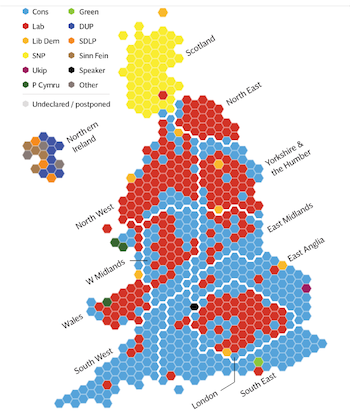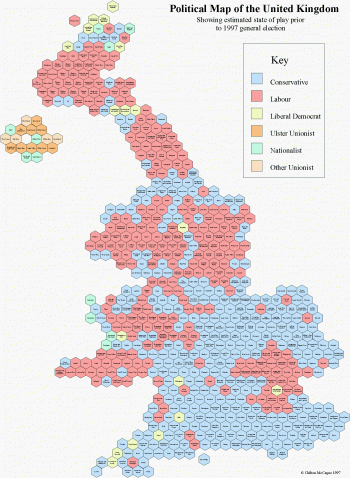We are developing the social individualist meta-context for the future. From the very serious to the extremely frivolous... lets see what is on the mind of the Samizdata people.
Samizdata, derived from Samizdat /n. - a system of clandestine publication of banned literature in the USSR [Russ.,= self-publishing house]
|
I invented that. Probably. You may have seen all sorts of weird hexagon-based maps of the United Kingdom in the last week or so. Here’s one from the Telegraph but lots of other people from Sky to the Guardian have their own versions:

The BBC had one filling up the square at Broadcasting House.
The reason for these maps is to do with the way people vote in the UK. People in rural areas vote Conservative (up until Thursay, that is) while people in urban areas vote Labour. When you take a geographically accurate map of the UK and colour it in according to who won what seat the map is almost entirely blue no matter what the overall result. If you make all constituencies the same size and carry out the same exercise hopefully you will get a much more accurate representation of what happened.
Here’s another map:

From 1997. Drawn up by yours truly. I believe it was the very first. One of the oddities is that all the subsequent maps have included my design flaw. It should be squares not hexagons.
|
Who Are We? The Samizdata people are a bunch of sinister and heavily armed globalist illuminati who seek to infect the entire world with the values of personal liberty and several property. Amongst our many crimes is a sense of humour and the intermittent use of British spelling.
We are also a varied group made up of social individualists, classical liberals, whigs, libertarians, extropians, futurists, ‘Porcupines’, Karl Popper fetishists, recovering neo-conservatives, crazed Ayn Rand worshipers, over-caffeinated Virginia Postrel devotees, witty Frédéric Bastiat wannabes, cypherpunks, minarchists, kritarchists and wild-eyed anarcho-capitalists from Britain, North America, Australia and Europe.
|






You may have got hexagons from some forms of wargaming Patrick – as you know some boards have hexagons to increase the number of directions one can move forces.
Still it is a fine thing to have invented map that can be used to represent these political matters.
I commend you for it.
I’m obviously missing some thing here, I can’t see how squares would be an improvement, it’d look a sprite from an 80s game.
e.g. diesel sweeties.
You’ve got me searching the darker recesses of my memory. I think the argument was that with squares you could include more information. They were also, at the time, easier to work with given the available technology.
Indeed they are, RlJ. The first link works. The second doesn’t.
Yeah, it does now.
Hexagons look much better than squares because they give the coastline a more natural look. That in turn makes it easier for the viewer to identify particular areas of the country that they are interested in, because the outline is more familiar.
I thought the hexagons came from the old table-top paper battlefields where we re-fought the battle of the bulge again and again in college dorms.
Happy to give you credit, though. Cheers.
Honey bees use hexagons. They work well for packing and hence storage.
Here’s another map which displays the result of the UK election in a slightly different way.
Yep, I remember it from Avalon Hill games. D-Day. Jutland. Midway, Bismarck… They hexagons let you move your troops/ships in a more realistic fashion.
What I find interesting is that in your maps (both your original and the other one you posted) the Conservative areas are in blue and the Labor areas are in red. In the US, we use the reverse color scheme: Republican (allegedly conservative) areas are red and Democrat areas are blue. I read somewhere that this was because the liberals/progressives/left-wingers/whatever-you-want-to-call-them realized that red was traditionally used to identify communists, from whom they were attempting to distance themselves, and they got ahold of the color scheme before anyone else knew what was up. Plausible. Perhaps your leftist are less afraid of being linked to communists?
Of course. Communism always enjoyed more legitimacy in Europe than in the US, although possibly maybe less so in England. (Whether that has really anything to do with the colors I have no idea).
Laird,
My recollection is that in the US in the early days of color TV, blue was traditionally Republican and red was Democrat. Years later I watched the inversion take place over a couple of cycles and smelled a rat at the time. Probably a preinternet version of JournoList for the reasons you mention. At a subconscious level however, this is better. Blue is the color of hypoxia, red is the color of sanguinity. 🙂
Traditionally the American TV networks would decide on their own which color (red or blue) to use for each party and change it every year. I think it was a quirk that in the 2000 elections every network used red for the Republicans and Blue for the Democrats. Therefore, when the close election kept the electoral maps in the public eye for a long time, some commentators began using “red state” and “blue state”.
However, like Midwesterner, I remember blue being more traditionally the Republican color on these TV maps.
Laird, I believe the inversion was fairly recent too. I’m thinking I heard it was the 2000 election.
I saw such maps earlier than 1997. The Daily Telegraph had one for the 1987 election result (using rectangles, not hexagons) that I kept for years because it did indeed show British political geography size-equalised.
Meanwhile, what does it say about us that so many commenters to this post, like me, find the hexagons remind them nostalgically of a time when they pushed square bits of cardboard across hexagon-gridded maps trying to outdo Wellington or Churchill or their enemies – or Lee or Grant. Almost all the US geography I know is of areas important in the Civil War. And as regards Russian geography, it was said you could always tell if someone was a war gamer by asking them where Roslavl was. 🙂
Like the Yanks above, I too remember being surprised (shocked and appalled) to learn that the Dems’ turf was suddenly Blue and the Heffalumps’ Red. Sa-a-ay WHAT???!!! Especially since it had become quite clear which was the party of socialism, which is certainly not an American ideal. Gulp.
However, memories are highly local, being physically bounded by a single cranium, and are also notorious for fading and “morphing” upon exposure to Time. So YrsTrly went on a Cyberquest, in this case an Ixquick search on the string Democrat states become blue (no quotes). Among the results are postings at
http://www.word-detective.com/2007/06/blue-state-red-state/
http://www.smithsonianmag.com/history/when-republicans-were-blue-and-democrats-were-red-104176297/?no-ist
There are plenty more results, but skimming the page most of the rest look to be either not pertinent or of questionable reliability (dailykos, mother jones, democratic underground, answers, wnd, …). From the Smithsonian piece, published October 31, 2012:
From the Word Detective’s much shorter piece of June 7, 2007, which interestingly steals my characterization of “true-blue” *grin*:
This is followed by four comments, one of which appears to be a re-posting of a Washington Post story (datelined November 2, 2004) and does not entirely agree with the foregoing. A link is given:
http://www.washingtonpost.com/wp-dyn/articles/A17079-2004Nov1.html
Red and Blue. The colours of The Bloods and The Crips. Funny, that.
t.o.r. — rueful LOL!
I think that the rebellious Anarchists chose Red because of its’ shock value, as well as being opposite to the blue-blood aristocracy. Also, ‘Left’ and ‘right’ come from the seating arrangement of the French National Assembly, in revolutionary days. Or so I have read.
Does Red appear on the outside, or the inside, of rainbows? If inside, then red IS naturally centralist!
In wargaming (the kind the military do) the enemy is traditionally red, hence friendly fire is ‘blue on blue’. In sci fi movies the bad guys are also usually red, for example the Sith use red lightsabres. In the recent Tron reboot the bad guys are red. I often wonder if the director is making a political point, and if so, which one?
IIRC the Labour Party used to sing The Red Flag quite openly. I’m not sure they still do that.
Those movies are usually done by Americans, who can’t get over the War of Independence, when the enemy wore… (wait for it…) Red coats! The American side, I believe, used blue. It would upset US audiences if the good guys used red, and the baddies wore blue.
Well played, sir. However I think it was the French* that wore blue. The US didn’t have a uniform at that time as they were a civilian militia.
*AKA cheese eating surrender monkeys. How quickly they forget.
The Red Flag has long (well over a hundred years) been an anthem of lefties in English language countries. It always used to be sung at Labour Party conferences – maybe it still is. So not specifically communist at all. (Though we need to remember that in the early days, socialists were pretty much all proper socialists, whether or not they were communists – none of your mimsy middle of the road stuff.)
According to wikipedia radical American lefties were quite happy to sing it too.
“The people’s flag is deepest red,
It shrouded oft our martyr’d dead
And ere their limbs grew stiff and cold,
Their hearts’ blood dyed its ev’ry fold.
Then raise the scarlet standard high,
Within its shade we’ll live and die,
Though cowards flinch and traitors sneer,
We’ll keep the red flag flying here.”
And if the blood of the martyrs turned out to be blue, we’d be talking about a whole different set of martyrs.
Nicholas (Self-Sovereignty) Gray – May 12, 2015 at 12:31 am:
Red is/was the socialist color. The anarchist color was/is black, e.g. the magazine Black Flag.
You are probably right on the anarchist’s colour, but they also liked red (A big red ‘A’ on black).
The Continental army did have uniforms, though mostly threadbare and catch-as-catch-can. Shoes were a big problem. And yes, the uniforms were basically blue. I understand the Hessians wore green.
I think the comment above is the first time I’ve seen the full text of the original version of the red flag song. During Maggie’s years, and on into Blair’s new-labour reset, it was common to sing a revised version in most places (except the labour party conference at which the original was still sung in an increasingly phoney ceremony towards the end). IIRC it began
“The people’s flag is palest pink;
It’s not as red as you might think.”
and ended
“By tax incentives, we have planned
To bring about the promised land.
But just to show that we’re sincere
We’ll keep the red flag flying here.”
Anyone who recalls the rest of the words by all means complete this. 🙂
In Britian, blue and red have meant right and left since forever. I’m sure I’m not the only one to find the “blue state’, ‘red state’ nomenclature bizarre when it occasionally appears in British reporting. (Usually, reports here translate – I only really know the terms from web news.)
Roue le Jour, the Continental Army wore blue coats although the local militia might have worn anything. The Royal French Army at the time wore white coats for their line infantry. Individual units or specialist troops might have different colors.